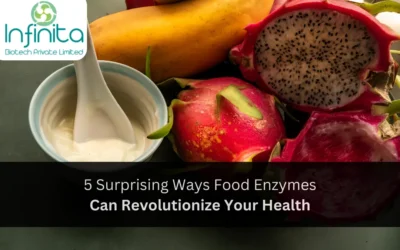Transglutaminase (also known as ‘TG’ in abbreviated form) is a ubiquitous and naturally occurring enzyme in plants, microbes, animals, and humans. Transglutaminase helps our bodies build muscle mass, assist in the digestion process, and destroy toxins in the body. Commercially, it is used to enhance flavours and develop texture in food, including meat products and bakery items. Transglutaminase binds the different types of meat together through the formation of bonds between proteins. These bonds are strong and can withstand physical stress and heat treatment. Therefore bacon can be joined with beef or mutton to create large cuts of combined meats. Due to this property, Transglutaminase is also known as “meat glue”.
Transglutaminase Enzyme Function
Transglutaminase catalyzes the cross-link of side chains of 2 amino acids that are lysine and glutamine in liquefied proteins. This leads to the yielding of ε-(γ-glutamyl)-lysine bond and the formation of iso-peptide bonds between proteins. This bond can withstand physical stress and heat treatment. As an enzyme, it helps the proteins of food items to bind together while remaining unaffected. It is used to improve the viscosity, firmness, elasticity, and water-binding capacity of food items. This leads to the enhanced flavour and improved texture of the food products. The cross-linking property of Transglutaminase is used in the commercial production of different food items. These include manufacturing bakery, cheese, and other dairy products, creating edible films, and the meat processing industry.
Transglutaminase Enzyme Applications
Transglutaminase catalyzes the acyl-transfer reaction between peptide bound glutamine residues and various primary amines, which include protein lysine residues. The cross-links introduced by Transglutaminase change the structure of proteins which leads to improvement in their functional properties. These include viscosity, texture and water retention capacity without any adverse effect on the nutritional quality of lysine residue.
Let us look at some other uses and functions of Transglutaminase in different industries-
- The use of Transglutaminase causes crosslinking of milk proteins. In cottage cheese and soft cheese production, the introduction of TG leads to higher gel firmness and combining of whey into the gel, which leads to increased cheese production by nearly 18%. Transglutaminase also is effective in lowering syneresis in acid milk gels and thus improves the texture and also shelf life of yoghurt. It is also used in the production of ice cream to give a superior mouth-feel.
- Making animal protein sources like poultry, seafood, and red meats uniform in size for even and safe cooking.
- Reducing food wastage and improving the flavour, texture, and appearance of food. This leads to a considerable amount of savings and reduced adverse environmental impact.
- Binding small pieces of animal protein like poultry, red meats, and seafood together to create a larger cut. A larger cut may be used to prepare mixed meat steaks and other dishes.
- For improving texture in different food products like imitation crab meat and sausages without casings.
- For enhanced gastronomic and fine dining experiences like creating shrimp-meat spaghetti and other meat noodles and pasta made of animal and vegetable protein combined.
Is Transglutaminase Safe?
TG is safe for human consumption and for combining meat products. Just like every other meat product, the TG added meat products have to be cooked at 63 degrees Celsius to eliminate potentially harmful microbes like E.coli or Salmonella. The enzyme also breaks down at this temperature and is not absorbed. Additionally, TG has been certified by various agencies like the U.S. Food and Drug Administration (FDA) and The U.S. Department of Agriculture (USDA) as safe to use.
Sources of Transglutaminase
Transglutaminase is a commonly found enzyme and thus derived from both animals and plant sources. Commercially this enzyme is extracted from a fermenting bacterium called Streptoverticillium mobaraense and is considered vegetarian and vegan.
Conclusion
Transglutaminase is an enzyme that is safe to use and consume and has several applications in the food production industry. It was first introduced in food products nearly twenty-five years ago. It is now used in a wide range of food items including cheese and dairy, bakery, and meat products.







